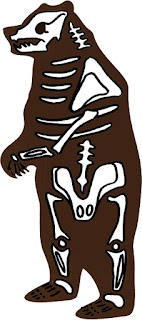FUN FACTS
1) A full head of human hair can support 12 tonnes. That's the same as 2 full grown African Elephants.
2) Humans are bioluminescent and glow in the dark.
3) A pair of feet can produce over a pint of sweat every day.
4) A human baby has over 60 more bones than an adult.
5) Inside your bellybutton are thousands of bacteria that form an ecosystem the size of an entire rainforest.
I bought a fruit yYoyo and looked at the card inside the current packs to see the kind of layout and content the Bear brand wanted to include.
These are the current bear fact cards for fruit yoyos. As you can see the fact only makes up a small part of the card where the other part is very story oriented with lots of visuals and statistics. For my design, I need to think of other things I could include the fact to fill it out a bit more.
This card includes
BACK
Fact File - in the style of a file
Mission-o-meter: with statistics like a top trump
Spy Score: With the overall score of the card
Expert / Pro / Rookie level of card
Where in the world the mission is from
Secret message you need magnifying glass to read
Punny mission name: 'Mission: KNOX, KNOX! WHO'S THERE?'
FRONT
Colourful vector imagery, lots of detail and things to look at
The country where the story / mission is based.
My Concept
I wanted to think of a logo, name, and storyline to do with the body to be the foundation for my concept which the set of cards could follow consistently. That's where I came up with Bear's Bonkers Bodies and Bear's Anatomy Adventure.
As the brief stated that BEAR wanted a design for a minimum of 3 cards, front and back and an accompanying 'collectible mechanic' I looked into storylines with an adventure style nature that could run alongside the collection of cards. The theme of being shrunken down and sucked into the body is a narrative common in multiple children’s television shows and films such as Arthur, Inner Space, Honey I shrunk the kids and the grown up cartoon series on Netflix, Rick and Morty. This idea also had the potential to be made into an interesting and fun series of facts and games.
Top: Rick and Morty, ‘Anatomy Park’ Bottom: Arthur, ‘Giantess’ & Inner Space
For the logo I thought of different things I could do to put on the cards.
Artist Jason Freeny is widely known for his surreal anatomical models of popular toys, such as sliced see-through barbie dolls and skeletal legos. His latest offbeat creations showcase the organs and bones of two more childhood joys: balloon dogs and rubber duckies.
I thought it would be cool to include this snapshot into the bear's body as part of the card.
This is a logo I mocked up:
It didn't really go to plan and I wanted the illustrations to be more wholesome and look hand drawn or screen printed etc. So I went back to the drawing board.
I also had a play around with some type that incorporated features of the body such as hair, teeth and muscle. Using Helvetica I experimented with this idea:
Again I wasn't overly happy with the results. This is where I went back to the drawing board, thinking about the concept I was actually looking into. I decided to do a doctor's waiting room style diagram of the bear logo, depicting different body parts of the Bear such as his hair follicles, teeth, paws and bones etc. I then combined it with a font with a very organic, hand drawn style. To finish the logo and make it look as hand rendered as possible I overlayed a printed texture to give it a grainy effect.








































